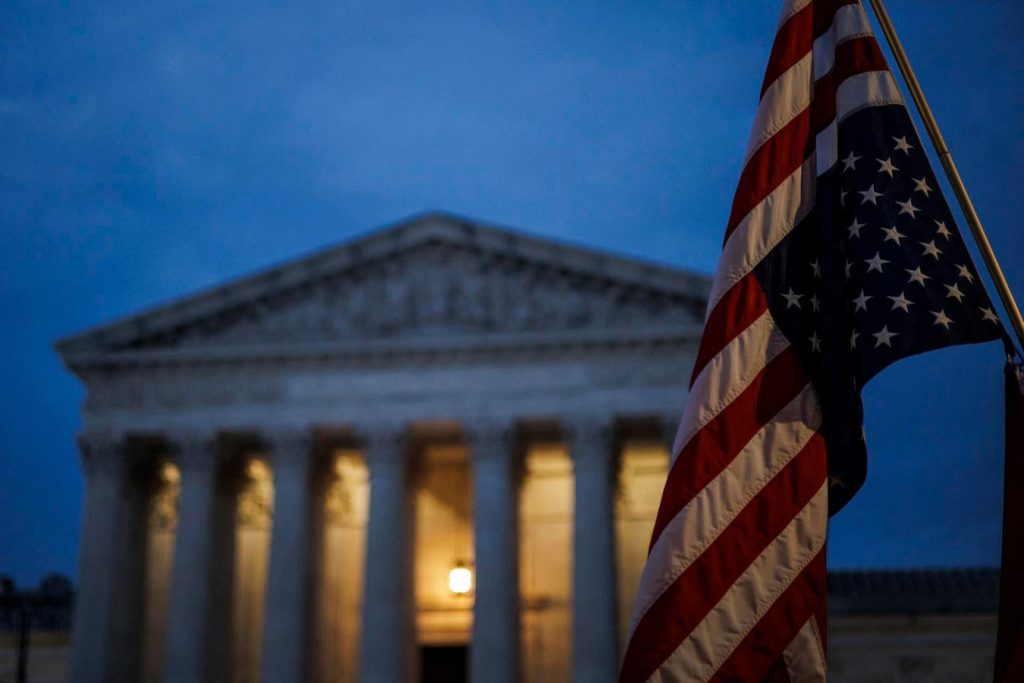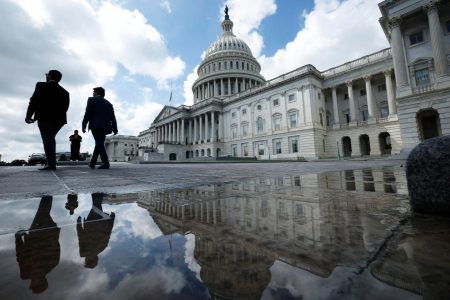Tax Notes contributing editor Robert Goulder breaks down the Supreme Court’s ruling in Moore v. United States and what it means for the tax world.
This transcript has been edited for length and clarity.
Robert Goulder: Hello, I’m Bob Goulder, contributing editor with Tax Notes, and we’re here to make sense of the Supreme Court decision in Moore v. United States that was released June 20. Taxpayers have been waiting for this decision for so long, and now we finally have some guidance from the high court.
As many people expected, the outcome is pretty much a resounding victory for the federal government, at least concerning the validity of section 965 of the Internal Revenue Code that is sometimes known as the mandatory repatriation tax or alternately as the one-time transition tax under the Tax Cuts and Jobs Act legislation. So a big victory for the government.
I suppose if we’re going to split hairs, you could say that the petitioners, the taxpayers, they don’t walk away completely empty-handed, and that’s because the majority did something interesting here. They basically decided not to decide on this issue of whether there is a constitutionally based realization requirement. So the big news, if you will, is that there’s no news on that.
The majority opinion, authored by Justice Brett Kavanaugh, he just sidestepped it. We’ll talk about it later. There’s a footnote where he said, “These are the things we’re not going to decide.” And it’s just interesting that there’s one thing that everyone thought the case was going to be about, namely the wealth tax. Well, they just are going to leave that for another day.
So in one sense, I suppose that’s a victory for the taxpayers because they didn’t lose on that. And procedurally, if you look at where this case came from, the Ninth Circuit, that lower court decision in the court of appeals, they came right out and said, “There is no such thing as a realization requirement.” And Justice Kavanaugh and the majority, they stayed away from that.
How did the case get before the Court?
This constitutional challenge was brought by two U.S. citizens, Charles and Kathleen Moore, a married couple. And what makes them interesting is that back around 2006, they invested some money in a foreign corporation, the company KisanKraft over in India that was active in the agricultural sector. And that company over the course of the years, it made lots of money, but it reinvested all of it back into the company’s retained earnings. It did not distribute it to the shareholders.
There were no dividends, at least not through the tax year in question, 2017. So that means those profits of the foreign corporation, they would’ve been subject to tax in India, but they were not taxed in the United States, again, because there’s no dividend.
Now normally, before the TCJA, any tax on such profits would’ve been deferred until you have a repatriation event, like a dividend. But then Congress comes along in December 2017 through the TCJA signed into law by President Trump and they eliminate, well, they changed a lot of things, but one thing they do is they eliminate the deferral system. And they also have this one-time transition tax, which the petitioners called the MRT, the mandatory repatriation tax. It’s applied retroactively by design because it’s reaching past years’ earnings and profits.
So the issue comes up: Can Congress lawfully impose a tax on undistributed earnings of a foreign corporation? Now, as the taxpayers see it, you’ve got the Article I taxing power, and the way they read the law, this calls for a realization requirement. The lower court said no.
And in particular, the Ninth Circuit came up with a very strongly worded opinion that said flatly, “There is no such thing as a realization requirement.” Hence, the appeal to the Supreme Court. The Supreme Court grants certiorari, we had oral arguments back in December, and we’ve been waiting ever since to see how this would play out.
What did the Court actually rule?
Well, this is where things get interesting. The Court rejected the Moores’ constitutional challenge. They did so on a 7-2 decision, again with the majority opinion written by Justice Brett Kavanaugh. We had a couple of concurrences.
There’s a concurring opinion by Justice Ketanji Brown Jackson that’s very interesting, and then a second concurring opinion — this is fascinating — by Justices Amy Coney Barrett and Samuel Alito. And if you go back and you listen to the transcripts or the audio recordings of the oral arguments from December, wow, you would’ve thought, especially Justice Alito was not on the government side here.
So it’s a bit interesting that based on the questioning with the counsel and oral arguments, you really thought he was going to come down on the side of the taxpayers. Not the case. So we have Justice Alito concurring with the majority.
And then the two dissenters in the 7-2 opinion, who are they? Justices Clarence Thomas and Neil Gorsuch. Again, not really a surprise if you go back and read the transcripts or listen to the audio recordings.
So the majority opinion, what did they decide? There’s a lot of discussion about the background of the Constitution and what it has to say about direct taxes versus indirect taxes. And in reading that portion of the opinion, I’m personally struck by how they resolve this in what seems like a very straightforward manner.
There’s a very matter-of-fact nature to how they connect the dots here and come to their conclusion. The Moores argue that section 965 is an unapportioned direct tax. So it’s a tax on their ownership of property, namely their shares in the foreign corporation. And procedurally, it’s their burden to establish that, and they simply failed in that regard.
Justice Kavanaugh comes right out and says they don’t make that case, that this is to be considered as a tax on property. They view it as a tax on income, meaning it’s categorized as an indirect tax for constitutional purposes rather than a direct tax. And the significance there is that indirect taxes under the Constitution are not subject to the apportionment clause. They’re subject to other things. They’re subject to the uniformity standard. But let’s be clear, uniformity is a very low hurdle.
Where did it all go wrong for the taxpayers? Where did they lose this? Well, at a basic level, the Moores wanted this to be a case about realization. And that just didn’t happen. The majority said no. They looked at what’s in front of them, and they said, “Section 965 is not about realization; it’s about attribution. The income in question that is the focus of section 965, that income was realized years earlier.”
Now, it was realized by someone or something else. It was realized by the foreign corporation over in India, and that income is then being attributed to the shareholders. But that makes it fundamentally a case about attribution, not realization. And once they lose on that issue, really everything else falls into place, and it becomes very straightforward.
There is this theory that was floated around in the petitioners’ brief called “constructive realization.” That did not go well with the Court. It was picked up on by Justice Neil Gorsuch in the dissent, but the majority and the concurring opinions, they didn’t like that. In fact, at one point, Justice Kavanaugh even sort of mocks the theory, calling it “a one-off label trying to distinguish two things which are not distinguishable” — namely, the treatment of subpart F income under the controlled foreign corporation rules and the treatment of these undistributed profits for section 965. Justice Kavanaugh writes as follows: “And if as the Moores concede, subpart F is not unconstitutional under the ‘constructive realization’ theory, then the MRT is likewise not unconstitutional on that theory.” There you have it.
In hindsight, it seems like the Moores, and their lawyers, painted themselves into a tight little corner when they decided to argue that the attribution from an entity to a shareholder that you get with subpart F, they said, that’s fine. They conceded the constitutionality of subpart F, but then they’re saying the same kind of entity-to-shareholder attribution that you get under [section] 965 is flawed.
When they painted themselves into that corner, they couldn’t get out because the one thing that comes across very clearly in the majority opinion is that they keep on talking about subpart F. It comes up over and over again. I lost track of how many times Justice Kavanaugh mentions subpart F in the majority. It was a lot. And he’s doing that to say you can’t really distinguish the two. You can’t differentiate the one type of attribution from the other type of attribution.
Now, I’ve talked about everything that this case is; I want to talk about what it’s not. To do that, we need to look at a footnote. Early on in the decision around page 8, there’s this footnote; it’s footnote two. And in any Supreme Court decisions, you got to read the footnotes because that’s where they tell you what they’re not deciding, right? They go out of their way to inform us what it’s not about. So it’s not about a wealth tax; it’s not about mark-to-market. It’s not about taxing “naked appreciation,” I’m using air quotes. That was a concept that came up during oral arguments.
The very first question out of the box during oral arguments, Justice Clarence Thomas asked, “Could Congress enact a tax on the naked appreciation of stock?” You go and you buy an asset; it increases in value. Could you tax that? At footnote two, the majority says, “We’re not deciding that, that’s not part of the structure of the TCJA. That’s not part of what’s going on with section 965, so we’re not deciding that.”
All right, as I mentioned, there’s a concurrence. Justice Ketanji Brown Jackson, she joins the majority. She’s one of the five justices that joins the majority. But then in addition to that, she has her own concurring opinion. Why did she do that? She wants to go one step further than the majority. She wants to come out and say, “Basically there is no realization requirement.”
Justice Jackson is agreeing with the Ninth Circuit, and she has to say that in a concurring opinion because the majority isn’t going to go there. We know from the outset they said we’re not going to address whether there’s a realization requirement.
Now, as I mentioned, there was a second concurring opinion that was from Justice Amy Coney Barrett joined by Justice Samuel Alito, and that concurrence is the exact opposite of the other concurrence from Justice Jackson. Those two justices, Barrett and Alito, they feel firmly that there does need to be a realization requirement. They want that to be out there in print stated, and they’re bothered by the fact that the Ninth Circuit went in this other direction. They could only express that view through a concurring opinion because a majority just wasn’t going to go there.
And then finally, the two dissenters, Justices Thomas and Gorsuch, they liked the petitioners’ argument. They saw nothing wrong with distinguishing between the attribution you get with subpart F, which is constitutionally valid, and the attribution you get with section 965, which they say is improper. To me personally, it kind of seems like they’re splitting hairs. And the other seven justices agreed that that was splitting hairs. So there you have it, 7 to 2.
What about the implications for a wealth tax?
Well, the answer there is simple. As things stand today, having read the opinion, I can tell you that we’ve learned absolutely nothing about the constitutionality of a federal wealth tax. Zip, zero, nada. Can’t tell you if it’s going to be upheld or rejected, or if Congress is ever going to pass one. The majority purposefully stayed away from that.
It all goes back to that footnote where they said, “We’re not going to get into any of that.” And they didn’t need to. In order to resolve the narrow issue of the legality of section 965, you don’t need to get into that. So if we were to tally up the support now, right, this is what people are going to do. They’re like, “OK, 7 to 2, we’ve got section 965 upheld. We get that. What is the existing support on the bench right now for a realization requirement?”
Well, we definitely have at least four justices who want there to be a realization requirement. That’s Justices Thomas, Gorsuch, Barrett, and Alito, but only two of them were willing to rule against section 965. So they disagree on the mandatory repatriation tax, but they agree that there needs to be a realization requirement. That’s four out of nine justices are good with a realization requirement.
There’s one firm vote against it, Justice Ketanji Brown Jackson. As for the other four justices, we have no idea where they stand on a realization requirement because of the majority decline to address it. And that does tell us something. It tells us we’re going to need a better test case.
One of the things that’s been written about Moore v. United States from the get-go is that it’s an interesting little case, a quirky case, but it’s really not a very good litmus test for what the Supreme Court is going to decide on either a mark-to-market regime or a federal wealth tax. If this was going to be your test case to determine the legality of a federal wealth tax, you picked the wrong test case.
So that’s one takeaway there that you’re going to have to do this again, which means we get to come back in some future year and go through all of this again. I have no doubt somewhere out there as we speak, some enterprising taxpayer is trying to figure out a way to bring a constitutionally based challenge against, say, the mark-to-market regime. They can’t bring a case against the wealth tax because it doesn’t exist yet, and the Supreme Court is not going to give you an advisory opinion on what kind of future uncodified tax provisions are going to be legal or not. So we’ll just have to wait. We’ll need to be patient.
So there you have it. My last word for day 1 of the universe as it looks after Moore v. United States has been decided is that the Court got it right. I think the majority opinion written by Justice Kavanaugh, I think it’s clear, it’s concise, it’s inspired, and really comes across as straightforward stuff. All of his discussion as to the constitutional text, the Article I taxing power, direct taxes versus indirect taxes, is this a tax on property, is it a tax on income?
All of the case law before the Court points to the latter, that this is a tax on income. So the apportionment is really beside the point. And he avoids deciding all of those things that he doesn’t need to decide to rule narrowly on the constitutionality of section 965. So I think it was a good result.
Read the full article here












